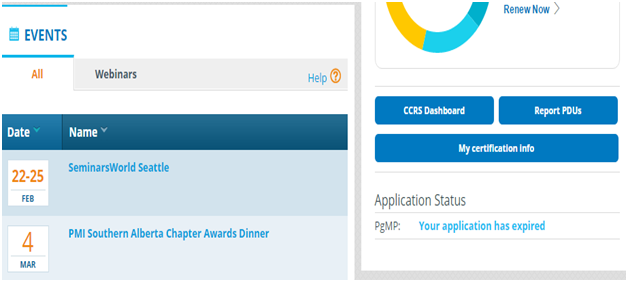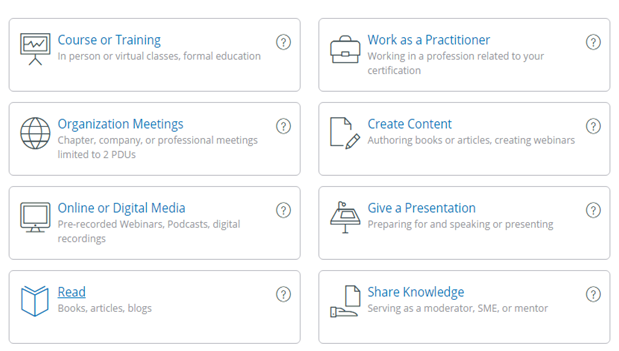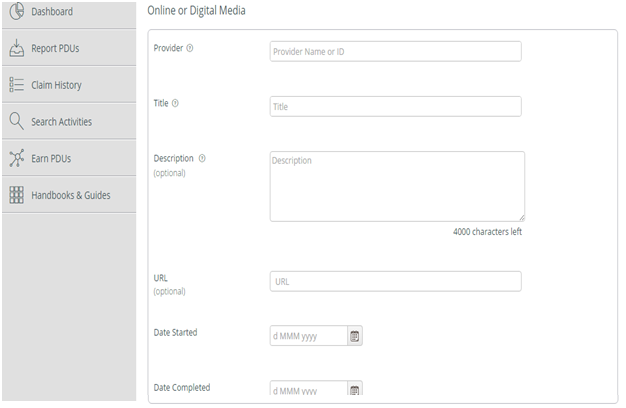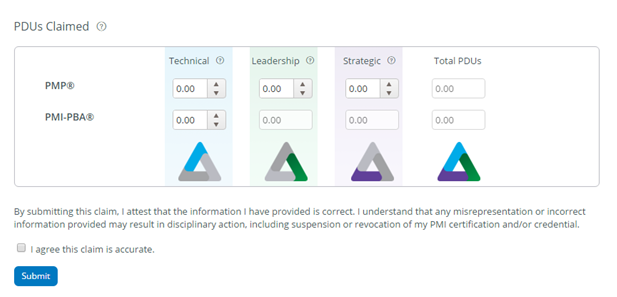Step – I: Check Your Eligibility
Here you will check your eligibility to apply for the PMP exam.
You need to fulfill three conditions to become eligible to apply for the PMP exam:
- You should be either a degree or a high school diploma holder. The degree or diploma can be in any discipline.
- If you are a degree holder you should have at least three years, and if you are a diploma holder you should have about five years of experience in leading and directing projects. This experience must have been earned within the last eight consecutive years.
- You must have attended a 35 contact hour training program for formal project management training.
If you satisfy these conditions, you can proceed to the next step.
Step – II: Collect all Information
Here you have to collect all information about the PMP exam. Go to the PMI website and explore it. Download the PMP handbook and read it from cover to cover. Read the frequently asked questions there and on my blog. I am sure you will get answers to all of your queries. If you still have some queries, you can post them in the comments section and I will reply to you.
Step – III: Join the PMI Membership
Once you are equipped with all the information, you should join the PMI membership. I strongly recommend you to do so. There are many benefits of PMI membership and you can realize them once you join.
The main benefit is a reduction in exam fees. In fact, the cost of the membership fee is less than the discount that you will get while applying for the PMP exam. Moreover, you can download the free digital copy of the PMBOK Guide free of charge; therefore, it is a win-win situation for you.
Step – IV: Collect Study Materials
After joining the PMI membership, you should start collecting materials for the PMP exam preparation. The material may include PMP exam reference books, manuals, slides, notes, PMP blog URLs, etc.
Since you are already a member of the PMI, you can also download the PMBOK Guide.
Now it’s time to start your pre-training study. You should start reading a PMP exam reference book; my recommendation is the Head First PMP. Read it from cover to cover and try to understand the concepts. If you are not satisfied with the first round, you can go for the second round. I am sure after the second round you will have a good understanding of the project management concepts.
Open the PMBOK Guide and study it. I know this is a dry and juiceless book and you may feel bored while reading it. This is the main reason why I recommend that you read any other reference book before reading the PMBOK Guide, because if you directly start with the PMBOK Guide you will feel bored, your confidence level may go down, and consequently, you may lose your interest in studying for your PMP exam.
Never start your exam preparation with the PMBOK Guide.
Step – V: Get PM Training
You have studied the PMP exam reference book and have gone through the PMBOK Guide, which means now you have a better understanding of the project management framework.
The next step for you is to obtain the 35 PDU’s /contract hour training for formal project management education. This is one of the three mandatory conditions from the PMI to be fulfilled in order to apply for the PMP exam.
Step – VI: Schedule the Exam
This is the most important step. After completing the training you must schedule the exam. You will never start studying seriously unless you schedule the exam. Once you schedule the exam, your hidden potential will be unlocked and you will start studying more aggressively, passionately, and punctually. I suggest you give yourself at least three months for exam preparation.
Step – VII: Start Exam Preparation
This is where you have to begin your exam preparation seriously. Start reading reference books, notes, and manuals. Now, read the PMBOK Guide and try to understand the process flow.
I suggest you buy atleast one good PMP exam reference books (Rita Mulcahy). Read the both books at least once.
The next step is to practice some sample questions. You can find a few sample questions at the end of each chapter in your reference books. You can also purchase a good PMP Exam Simulator from us to practice more questions. We offer 8 sets of simulation tests with 200 questions each.
Practice these questions and then attempt the mock test. The mock test is similar to the real test and consists of 200 questions. By reviewing the results of these tests, you can find out which domains you are not performing well in. Revisit those domains and fill in your knowledge gaps.
In the PMP exam you are going to see many mathematical questions. Although they seem to be tough initially, if you practice those questions and understand the concepts, they will become easier over time.
Therefore, try to practice these questions as often as you can. To help you solve these types of questions, I have written a PMP Formula Guide. This guide explains all mathematical formulas mentioned in the PMBOK Guide. You can use this eBook to understand the mathematical concepts for the PMP exam.
The PMP certification exam is based on the PMBOK Guide, and a lot of the questions in your exam will be directly from the PMBOK Guide. Therefore, read and understand the PMBOK guide thoroughly. If you skip the PMBOK Guide, it will be very difficult for you to pass the exam.
I recommend you read the PMBOK guide at least three times before attempting the exam. Although it is a dry book, once you start understanding the concepts, you will start liking it.
Step – VIII: Attempt the Exam
Be sure to reach the Pearson Vue center at least 30 minutes before your scheduled exam time to complete all formalities. It takes around 5 to 10 minutes to complete all exam procedures. Afterwards, you will be allowed to enter the test room, and your test will start.
As your test starts, you will be made aware of the display on the computer screen and navigation; e.g. how to select an answer, how to mark a question for review, etc. It will take 15 minutes to complete this awareness session. You can also finish this session in less than 15 minutes; however, once you end the session, your exam will start immediately and you will not be able to use the time that you saved.
Therefore I suggest you become comfortable with the navigation quickly and utilize the remaining time to note down some difficult to remember formulas or any confusing concepts on the paper provided by the Pearson Vue center.
The PMP exam consists of 200 questions and you have to answer these questions in four hours; i.e. 1.2 minutes per question. From my experience, I can say that if you are well prepared for the exam, this time is more than enough for 200 questions. Many aspirants who have passed the PMP certification exam and became a PMP on average took two and a half to three hours to complete the exam.
Take your time to complete the exam and review the answers in the remaining time, and then submit it. After submission there will be a short survey, and after the survey you will be able to see your result. If you pass the exam, the PMI will congratulate you; otherwise, they will offer their condolences.
If you pass the exam, you will receive the congratulatory mail within one week and your name will be updated in the PMI certification registry, and then you can see your name there. You will receive your certificate within four to six weeks, although officially PMI says that it will deliver your certificate package within eight weeks.
Please note that, in the PMP certification exam, there is no negative marking. Therefore, you must attempt all questions and give answers for them. Even if you don’t know the answers to a few questions, select the best guess. Never leave any answer blank on your exam.
Before I end this blog post, let’s summarize the key points:
- Collected all information.
- Collect study materials.
- Become a PMI member.
- Read the PMP exam reference book and the PMBOK Guide.
- Attend a 35 contact hours training program.
- Schedule the PMP exam.
- Start studying seriously.
- Take the exam and pass it.
Summary
The PMP exam is not very tough. If you plan well and study in the right way you can pass the exam in the first attempt. You can get help from your colleagues and professionals who have passed the PMP exam. You can find many PMP certification holders in your local chapter meetings. Approach them politely and ask for help; they will definitely help you in your preparation. Learn from their experience, prepare well, and pass the exam.
Good luck on your PMP exam preparation.







